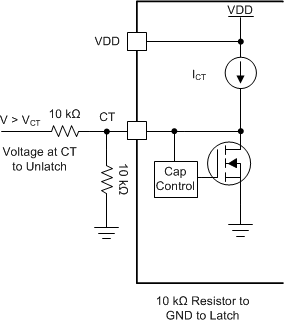SBVS344D November 2018 – March 2021 TPS3703-Q1
PRODUCTION DATA
- 1 Features
- 2 Applications
- 3 Description
- 4 Revision History
- 5 Device Comparison
- 6 Pin Configuration and Functions
- 7 Specifications
- 8 Detailed Description
- 9 Application and Implementation
- 10Power Supply Recommendations
- 11Layout
- 12Device and Documentation Support
- 13Mechanical, Packaging, and Orderable Information
Package Options
Mechanical Data (Package|Pins)
- DSE|6
Thermal pad, mechanical data (Package|Pins)
Orderable Information
9.1.3 RESET Latch Mode
The TPS3703-Q1 features a voltage latch mode on the RESET pin when connecting the CT pin to common ground . A pull-down resistor is recommended to limit current consumption of the system. In latch mode, if the RESET pin is low or triggers low, the pin will stay low regardless if VSENSE is within the acceptable voltage boundaries (VIT–(UV) < VSENSE < VIT+(OV)). To unlatch the device provide a voltage to the CT pin that is greater than the CT pin comparator threshold voltage, VCT. The RESET pin will trigger high instantaneously without any reset delay. A voltage greater than 1.2 V to recommended to ensure a proper unlatch. Use a series resistance to limit current when an unlatch voltage is applied. For more information, Section 9.2.2 gives an example of a typical latch application.
 Figure 9-3 RESET Latch Circuit
Figure 9-3 RESET Latch Circuit